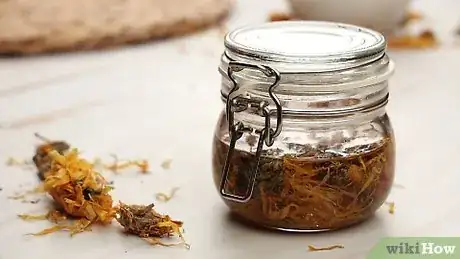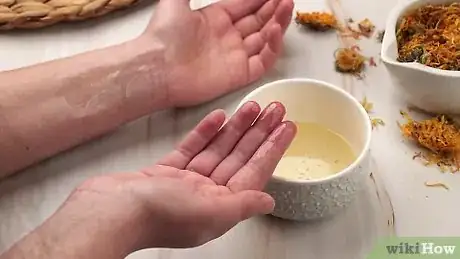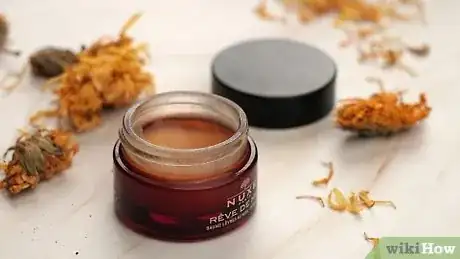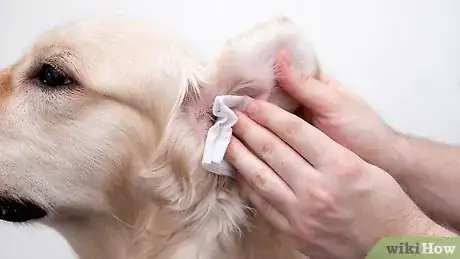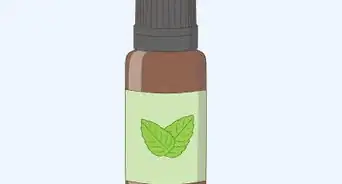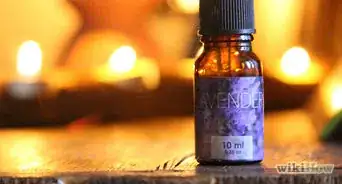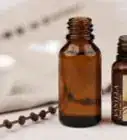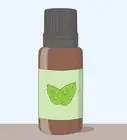This article was co-authored by wikiHow Staff. Our trained team of editors and researchers validate articles for accuracy and comprehensiveness. wikiHow's Content Management Team carefully monitors the work from our editorial staff to ensure that each article is backed by trusted research and meets our high quality standards.
The wikiHow Video Team also followed the article's instructions and verified that they work.
This article has been viewed 24,453 times.
Learn more...
Calendula (Calendula officinalis), also known as pot marigold, is a flower whose essence can be extracted and used for a variety of cosmetic and medicinal uses. Calendula oil has a favorable effect on the skin in cosmetic preparations, has been proven highly successful in the healing of chapped and cracked skin, and also has anti-inflammatory properties. Because of its healing power, calendula oil has been used in ointments and tinctures throughout Europe and America for hundreds of years.[1]
Steps
Gathering Ingredients and Supplies
-
1Pick or buy calendula. While you can buy dried calendula flowers at a herb store or online, many people making calendula oil make it with flowers they grow themselves. Pick the flowers when they bloom, when these blooms are at their peak, but wait until mid day so that the dew has evaporated from the petals.[2]
- Calendula oil is made with just the flower of the plant. Pick the flowers right under the bloom, below the base of the flower which holds the petals.
- You should pick calendula flowers as they bloom, collecting them over the course of a week or two. This will assure that the blooms are picked when they are in the best condition.[3]
- You can make the oil with a few or a lot of calendula flowers. As long as you have at least a quarter cup, you can infuse them into oil.
-
2Dry your calendula. Calendula flowers need to be dried slowly, at a low temperature. If you have a dehydrator, it will be great for this job. Keep the heat at or below 90 degrees fahrenheit. If you don't have a dehydrator, simply lay the flowers out on a clean kitchen towel, place them in a spot out of direct sunlight, and let them dry for a week or two.[4]
- Calendula oil can be made with fresh flowers. However, the risk of mold growing as the calendula infuses in oil is greater with fresh flowers because they contain so much moisture. This is why using dried flowers is suggested.[5]
Advertisement -
3Pick an oil. Calendula oil can be made with a wide variety of neutral oils. Many people use a very light oil, such as safflower or grapeseed oil, while others prefer olive oil to make their infusion. [6] [7]
- Jojoba oil can also be added to the infusion, although it is usually used in combination with another less expensive oil.
-
4Gather supplies needed for infusion. Making Calendula oil requires very few supplies. You only need a glass container with a lid and something to stir the mixture, such as a spoon.
- The size of your glass container will depend on the amount of calendula flowers you want to use to make oil. Pick a container that fits all of your flowers with room to spare.
- A see through glass container works well because the sunlight can get into the container and you can easily keep an eye on the mixture while it steeps.
Making the Oil Infusion
-
1Place the flowers into the glass container. The amount of flowers you use varies depending on the size jar you use and how much Calendula oil you want to make. For example, if you are using a pint jar, you will want to use no more than a cup and a half of Calendula flowers so that there is plenty of room for the oil to cover them all completely. This will make between a cup and two cups of Calendula oil, depending on how much oil you add.
- You do not want to pack the flowers into the container tightly, as you want the flowers to be totally encased in oil. On the other hand, you don't want just a few flowers and a ton of oil. This will make a very, very weak calendula oil.
-
2Pour the oil into the glass container. The goal is to completely cover the calendula petals with the oil. Keep pouring oil into the container until the flowers are totally covered, shaking the jar slightly to get rid of large air bubbles. It is a good idea to have at least one inch of oil above the flower petals, so that it is assured that they stay covered.
- You can also stir the mixture a little bit to make sure the flowers are covered with oil and that there are no big air bubbles. With your spoon, finish by pushing all flowers into the oil so they are all submerged.
- There should not be any pieces popping out. If there are, push them down or add more oil.
-
3Place the container in direct sunlight. The mixture needs the slow and steady heat of the sun to really infuse. To get the heat it needs, you can put it outside or inside, depending on where you live.
- Usually a south facing window is best. This should get a lot of sun during the summer.
- If you live in an area where there are animals that might knock it over or mess with it for some reason, put it inside by a window. If you can safely put it outside where no one or no animal will take it, putting it outside would be better.
- Ideally, oil making should be done in summer, so when the oil is set in a window it heats up. If you are making the oil at any other time of year, gently heating up the oil and herbs and stewing it for 10 minutes on a very low heat is a good idea. This will approximate the heating that the sun does to the mixture.
-
4Leave the mixture for a minimum of two weeks. Gently shake the mixture daily for a moment or two to mix it up and make sure all the flowers are submerged. The mixture needs this time to gently combine.
- If you leave your mixture in the window for more time, you will get a stronger oil. Once you get some practice at making the oil, you can decide how long is perfect for your desired strength of oil.
-
5Strain the oil. Place the oil mixture into a coffee filter, a piece of muslin, or in cheese cloth over another glass container.[8] Once strained, the macerated oil is now ready for use.
- You can use different strainers to get different purities of oil. For example, a cheese cloth will filter the oil less than a coffee filter.
Using Calendula Oil
-
1Apply directly to the skin. Calendula oil can be applied straight on the skin is said to heal certain ailments. In Ayurveda practice, an ancient holistic healing practice, calendula oil is used to cure athlete's foot, varicose veins, eczema, and skin infections.
- To apply to the skin, simply put a small amount of the oil on a cotton ball and wipe it onto your skin. The oil should absorb into your skin relatively quickly, especially if your skin is dry.
-
2Use oil to make lotion, salve, and lip balms. Calendula oil can be used as is on dry, cracked skin or it can be added to other carrier oils, creams, and lotions. However, usually it is made into an ointment.
- To make an ointment, also known as a salve, combine 3/4 cup of your calendula oil with 1/4 cup of coconut oil and 1 ounce of beeswax in a pan over a double boiler. Heat the mixture until it is completely melted and thoroughly combined. Then pour it into a container, such as several glass jars, and allow to cool. Once cool, it's ready to use.
-
3Use calendula oil for other purposes. There are a wide variety of uses for calendula oil. For instance, you can use it to calm an ear ache. Simply put a few drops into the affected ear and this will ease moderate inflammation.[9]
- You can also apply calendula oil to your dog's ears to stop ear mites.[10] Rub a few drops in the visible part of the ear to deter mites.
References
- ↑ http://www.herbalpedia.com/calendula.pdf
- ↑ http://www.herbalpedia.com/calendula.pdf
- ↑ http://www.rootsimple.com/2011/03/harvesting-and-drying-calendula/
- ↑ http://www.rootsimple.com/2011/03/harvesting-and-drying-calendula/
- ↑ https://thenerdyfarmwife.com/calendula-oil-salve/
- ↑ https://thenerdyfarmwife.com/calendula-oil-salve/
- ↑ http://www.rootsimple.com/2011/07/how-to-make-a-calendula-oil-infusion/
- ↑ http://www.rootsimple.com/2011/07/how-to-make-a-calendula-oil-infusion/
- ↑ http://www.motherearthliving.com/health-and-wellness/natural-healing-ease-ear-infections-naturally.aspx
About This Article
To make calendula oil, start by picking or buying calendula flowers. Next, dry your calendula with a dehydrator or by laying the flowers in direct sunlight for 1-2 weeks. Then, pick a neutral oil, like safflower or grapeseed oil, for your infusion. Once you have your supplies ready, place the dried flowers in a glass container and pour the oil over the petals until they are completely covered. After the flowers are immersed in oil, put the lid on, and place the container in direct sunlight. Finally, after 2 weeks, strain the oil, which is now ready for use. To learn how to use calendula oil directly on your skin, keep reading!





